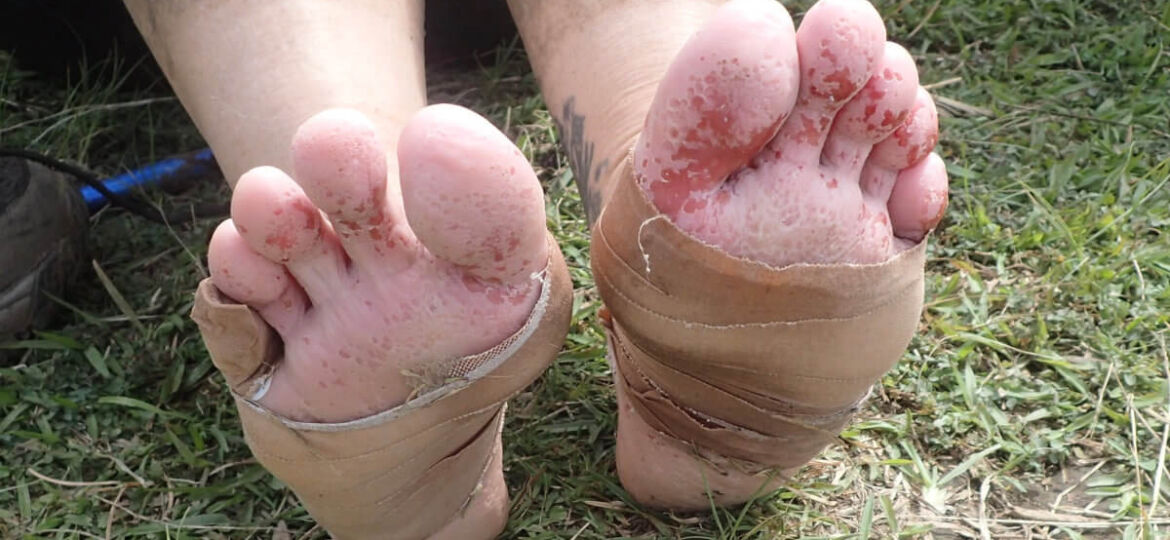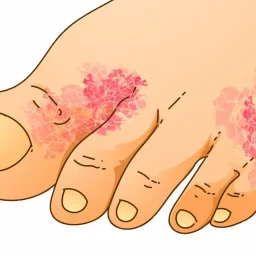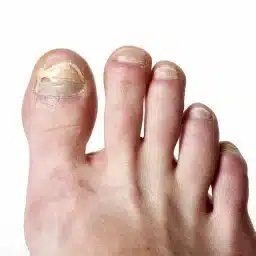
Trench foot, also known as immersion foot, is a painful and debilitating condition that primarily affects the feet. It earned its name during World War I when soldiers fighting in trenches were often exposed to cold, wet, and unsanitary conditions for prolonged periods.
The condition occurs when the feet are subjected to prolonged moisture and cold, causing damage to the skin, blood vessels, and nerves. Symptoms of trench foot typically include pain and swelling in the affected area, often accompanied by numbness or a tingling sensation. In severe cases, blisters, open sores, and even tissue death (gangrene) can develop. This is why trench foot treatment is important to avoid further issues.
Today, trench foot is rare in military settings due to improved footwear and awareness. However, it serves as a historical reminder of the importance of foot care in extreme environmental conditions, and the principles of keeping the feet clean, dry, and well-ventilated remain vital in preventing this condition.
What Is Trench Foot?
Trench foot is a non-freezing cold injury that develops when feet remain exposed to damp, cold conditions for prolonged periods, typically 12 hours or longer. This condition damages the skin, blood vessels, nerves, and muscles in the feet through a combination of moisture exposure and reduced circulation. Unlike frostbite, which requires freezing temperatures, trench foot can occur in temperatures as warm as 60°F (15°C) when combined with wet conditions. The name originates from World War I, when soldiers standing in waterlogged trenches for days developed this debilitating foot condition. Today, trench foot remains a concern for anyone whose feet stay wet and cold for extended periods—including hikers, outdoor workers, flood victims, and even individuals who wear damp footwear in air-conditioned environments. The condition causes blood vessels to constrict, reducing oxygen and nutrient delivery to foot tissues, which leads to tissue damage if not treated promptly.
Let’s Dive into the Symptoms of Trench Foot
The symptoms of trench foot can be quite uncomfortable and often develop gradually as a result of prolonged exposure to cold, wet conditions. Recognizing these symptoms early is essential for effective treatment and to prevent complications.
- Pain and Discomfort: Trench foot usually starts with a general discomfort and pain in the feet. This discomfort can vary from mild to severe.
- Swelling: Affected feet can become noticeably swollen, which may lead to difficulty fitting into footwear.
- Numbness or Tingling: Many individuals with trench foot report numbness or a tingling sensation in their feet. This is often an early sign of nerve damage due to compromised blood flow.
- Redness and Blanching: The feet may appear red at first, but as the condition progresses, they can become pale or bluish-white when exposed to warmth. This color change is a result of impaired blood circulation.
- Blisters and Sores: As trench foot worsens, blisters and open sores may develop. These can be painful and increase the risk of infection.
- Skin Peeling: In some cases, the skin on the feet may begin to peel, revealing raw, tender areas.
What Causes Trench Foot?
Trench foot occurs when the feet are exposed to prolonged cold and wet conditions, which causes the blood vessels and nerves in the feet to be compromised.
- The primary cause of trench foot is immersion in cold water for extended periods, typically below 60°F (15°C).
- When the feet remain wet for long durations, the skin loses its ability to regulate temperature, and blood flow becomes restricted. This lack of circulation can cause tissue damage and nerve damage.
- While trench foot was most commonly seen among soldiers during World War I, it can still affect individuals today, especially those who work or spend time in wet, cold environments such as hikers, campers, or people in flood-prone areas.
- The condition is also exacerbated by tight or poorly fitting footwear, which can further restrict blood flow.
How Is Trench Foot Diagnosed?
Diagnosing trench foot typically involves a physical examination, where a doctor will assess the feet for common symptoms like swelling, redness, and blisters.
- The medical professional will also inquire about the patient’s exposure to cold and wet conditions and the length of time their feet were submerged.
- In more severe cases, additional diagnostic tests may be conducted to assess the extent of the damage, including imaging studies to determine the health of the blood vessels and nerves in the feet.
It’s important to consult a healthcare professional as soon as possible, especially if symptoms like numbness, tingling, or blisters appear, as early intervention can prevent further complications.
What Are the Complications of Trench Foot?
If left untreated, trench foot can lead to severe complications that can cause long-term damage.
- The most significant risk is infection, as the damaged skin and tissue can become a gateway for bacteria to enter the body.
- Open sores and blisters that result from trench foot are highly susceptible to infections, which can quickly spread if not properly treated.
- In severe cases, the tissue may die, leading to gangrene, which may require amputation to prevent the spread of infection.
- Chronic trench foot can also cause nerve damage, resulting in persistent numbness or tingling in the feet.
- Additionally, individuals who experience trench foot may develop issues with blood circulation, which can contribute to long-term foot problems.
Seeking medical care as soon as symptoms of trench foot appear is crucial to avoid these complications and ensure proper healing.
How Can You Treat Trench Foot?
Trench foot, a condition caused by prolonged exposure to wet and cold conditions, can be treated effectively when caught early. Treatment primarily focuses on warming and drying the affected feet, improving blood circulation, and preventing further exposure.
- Remove Wet Socks and Shoes: The first step is to remove wet socks and shoes immediately. This allows the feet to start drying and rewarming.
- Gently Clean and Dry: Thoroughly clean and gently dry the feet. Avoid excessive scrubbing or friction, as the skin may be fragile.
- Warm Soaks or Packs: Soaking the feet in warm water or applying warm packs can help gradually raise their temperature. Ensure the water is not too hot to prevent burns.
- Elevate the Feet: Elevating the feet can aid in improving blood flow. Keep them elevated whenever possible.
- Wear Clean, Dry Socks: Put on clean, dry socks once the feet are warm and dry. Moisture-wicking socks can help keep the feet dry.
- Avoid Further Exposure: Prevent further exposure to wet and cold conditions. Use waterproof footwear and change wet socks promptly.
In more severe cases of trench foot or when left untreated, complications can arise, including infections and tissue damage. Seeking medical attention is crucial if the condition does not improve or worsens.
Prevention is key when it comes to trench foot. Keeping feet clean, dry, and well-insulated when exposed to wet and cold environments is essential.
Find the Best Doctor for Trench Foot Near You
If you’re dealing with trench foot or other foot-related concerns, finding a skilled podiatrist is crucial for effective care. Certified Foot and Ankle Specialists are dedicated to providing expert diagnosis, treatment, and prevention for trench foot and similar conditions. With a team of experienced podiatrists, they offer personalized care to help you recover and prevent further issues. Trust Certified Foot and Ankle Specialists to guide you back to optimal foot health and comfort. Take the first step toward healthier feet by scheduling a consultation today.
Frequently Asked Questions About Trench Foot
1. What causes trench foot and why should Florida residents be concerned about cold feet?
Trench foot develops when feet remain wet and cold for extended periods, typically 12 hours or more. While Florida’s warm climate might seem protective, trench foot can affect anyone whose feet stay damp in cooler weather, especially during winter months or air-conditioned environments. The condition occurs when prolonged exposure to moisture and cold temperatures (even as warm as 60°F) restricts blood flow to the feet. Florida residents who work outdoors, participate in water activities, or wear wet footwear for extended periods remain at risk, particularly during the cooler season from December through March.
2. What are the stages of trench foot and how does it progress?
Trench foot progresses through several distinct stages. The initial stage involves pale, numb, cold feet with a tingling sensation as blood vessels constrict. In the second stage, feet become red, hot, and painful as blood flow returns, often accompanied by swelling and blistering. If untreated, the condition advances to a third stage where tissue damage becomes severe, potentially leading to ulceration and infection. Early recognition and treatment are critical to prevent progression to advanced stages where tissue death may occur. Florida’s humidity can actually accelerate progression if moisture isn’t properly managed.
3. Can trench foot lead to a serious foot infection?
Yes, trench foot significantly increases the risk of foot infection. As the condition damages skin and tissue, it creates openings where bacteria can enter. The compromised tissue has reduced blood flow, making it harder for your immune system to fight infection. Warning signs of infection include increased redness, warmth, pus or drainage, red streaks extending from the affected area, fever, and worsening pain. Florida’s warm, humid environment can promote bacterial growth, making prompt medical attention essential if you suspect infection. Without proper treatment, these infections can spread and become life-threatening.
4. Is trench foot a chronic condition that requires long-term management?
While trench foot itself is typically an acute condition that resolves with proper treatment, it can lead to chronic complications if not addressed promptly. Some individuals develop long-term sensitivity to cold temperatures, chronic pain, or recurring circulation problems in their feet. Previous trench foot damage may also increase susceptibility to future episodes. However, with early intervention and appropriate care, most people fully recover without chronic issues. Florida residents should maintain year-round foot care practices, including keeping feet dry and protected, to prevent both acute episodes and potential chronic complications.
5. How can I prevent trench foot during Florida’s rainy season and water activities?
Prevention focuses on keeping feet dry and maintaining proper circulation. Change out of wet socks and shoes immediately, especially during Florida’s summer rainy season. Choose moisture-wicking socks and waterproof footwear for outdoor activities. If your feet get wet, dry them thoroughly and elevate them to promote blood flow. Take regular breaks to remove shoes and allow feet to air out, particularly important in Florida’s humid climate. For water sports enthusiasts, limit exposure time and warm feet gradually afterward. Avoid tight footwear that restricts circulation, and inspect your feet daily for early warning signs like persistent coldness, numbness, or discoloration.














